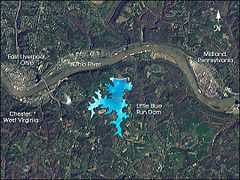Little Blue Run Lake
| Little Blue Run Lake | |
|---|---|
 NASA image of Little Blue Run from 2002 | |
| Location | United States |
| Coordinates | 40°37′32″N 80°30′36″W / 40.6256212°N 80.5100673°WCoordinates: 40°37′32″N 80°30′36″W / 40.6256212°N 80.5100673°W |
| Lake type | artificial lake |
Little Blue Run Lake or Little Blue Run is the largest coal ash impound in the United States.[1] FirstEnergy owns the site, located in Pennsylvania, and has disposed of billions of gallons of coal waste into the body of water. Several court cases have been brought against the company as a result of the damage caused by the company's practices at the site.
Description
The artificial lake was completed in 1975[2] and is located in both Beaver County, Pennsylvania and West Virginia and is owned by FirstEnergy, a publicly traded company with assets worth $48 billion in 2010.[3] The lake covers 1,900 acres[2] and the waste in the lake is prevented from escaping thanks to a 400-foot tall, 2,200-foot wide rock-and-earth dam.[3] Coal slurry from Bruce Mansfield power plant in Shippingport is piped into the lake.[4]
Toxic waste and risks
The lake contains 20 billion gallons of coal ash and smokestack scrubber waste.[2] The northern coast of the lake is only a few hundred meters from the Ohio River.
The Pennsylvania Department of Environmental Protection estimates that if the dam failed it would affect 50,000 people and has mandated that coal ash cannot be added to the lake after 2016.[3] In 2015 Vice news reported that dangerous pollutants were leaking from the body of water into the local community.[1]
Lawsuits against FirstEnergy
At least two lawsuits against FirstEnergy have been filed. The first was by the Pennsylvania Department of Environmental Protection which settled their dispute outside of court by agreeing that FirstEnergy would stop dumping coal ash into the lake after 2016.[4] FirstEnergy is required to clean up the site by 2031 but in April, 2014 FirstEnergy agreed to have the site cleaned by 2028.[2] FirstEnergy is required to cover the ash with two layers of impermeable "geotextile" sheeting to keep unhealthy chemicals from entering the local groundwater, it must monitor noise, odors and particulate emissions, conduct quarterly reconnaissance of contaminated water seepage from the lake and take corrective actions when necessary.[2] According the Pennsylvania Department of Environmental Protection, FirstEnergy is also required to monitor the site "for as long as environmental problems remain at the site."[2]
The second lawsuit was a federal lawsuit by 15 Beaver County residents and 36 West Virginia residents who accused FirstEnergy of contaminating groundwater and leaking hazardous waste like arsenic, sulfates, sodium, calcium, magnesium and chloride[2] into local waterways and groundwater systems. The dispute with the Pennsylvania residents, a minority of the parties who claim to have been affected, was resolved in February 2015 outside of court for an undisclosed settlement.[4]
References
- ↑ 1.0 1.1 "Toxic Waste Spill in North Carolina: Coal Ash". Vice. 19 February 2015. Retrieved 2 April 2015.
- ↑ 2.0 2.1 2.2 2.3 2.4 2.5 2.6 Hopey, Don (3 April 2014). "Little Blue Run coal ash site to close sooner; Plant owner must contain pollution". Pittsburgh Post-Gazette. Retrieved 2 April 2015.
- ↑ 3.0 3.1 3.2 Mountcastle, Brooks (31 March 2015). "Brooks Mountcastle: New coal-ash rule doesn't do enough to protect communities". Allentown Morning Call. Retrieved 2 April 2015.
- ↑ 4.0 4.1 4.2 Bowling, Brian (9 February 2015). "FirstEnergy, Beaver County residents reach agreement in Little Blue Run lawsuit". Retrieved 2 April 2015.